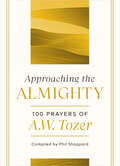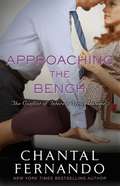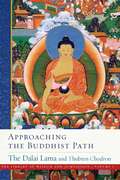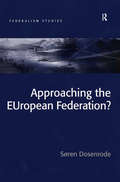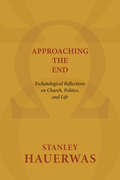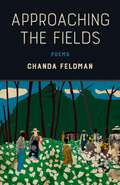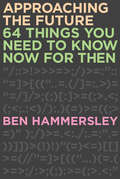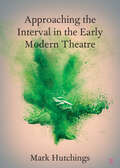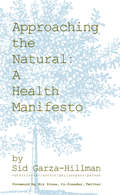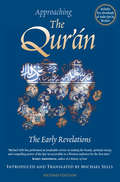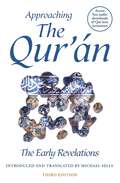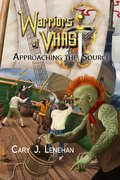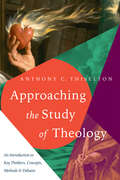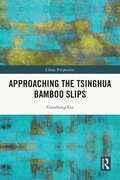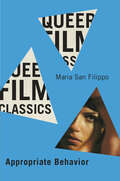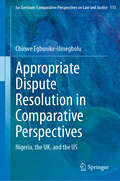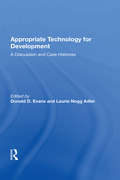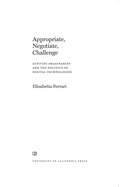- Table View
- List View
Approaching the Almighty: 100 Prayers of A. W. Tozer
by A. W. TozerDiscover the never-before-published prayers of A. W. Tozer as he opens his sermons.Is there a holier moment than when a preacher steps into the pulpit and opens the Scriptures before the people of the Lord? A. W. Tozer certainly understood the gravity and sanctity of that moment. His pulpit prayers reflect the holy awe that he experienced as he stood before God and the gathered congregation.Although Tozer fans are familiar with his writings and sermons, now for the first time, Approaching the Almighty collects the prayers that Tozer offered as he stepped into the pulpit to preach. Phil Shappard, a Moody Radio manager whose job was to remaster the audiotapes of Tozer&’s sermons, has collected and transcribed almost two hundred prayers that reveal the great preacher&’s intimate walk with God.The path to a rich prayer life is to pray alongside others whose faith is deep. Let Tozer&’s pulpit prayers guide your own heart in its steadfast pursuit of God.
Approaching the Almighty: 100 Prayers of A. W. Tozer
by A. W. TozerDiscover the never-before-published prayers of A. W. Tozer as he opens his sermons.Is there a holier moment than when a preacher steps into the pulpit and opens the Scriptures before the people of the Lord? A. W. Tozer certainly understood the gravity and sanctity of that moment. His pulpit prayers reflect the holy awe that he experienced as he stood before God and the gathered congregation.Although Tozer fans are familiar with his writings and sermons, now for the first time, Approaching the Almighty collects the prayers that Tozer offered as he stepped into the pulpit to preach. Phil Shappard, a Moody Radio manager whose job was to remaster the audiotapes of Tozer&’s sermons, has collected and transcribed almost two hundred prayers that reveal the great preacher&’s intimate walk with God.The path to a rich prayer life is to pray alongside others whose faith is deep. Let Tozer&’s pulpit prayers guide your own heart in its steadfast pursuit of God.
Approaching the Atonement: The Reconciling Work of Christ
by Oliver D. CrispIn many ways, the death of Jesus Christ on the cross stands at the heart of the Christian faith.
Approaching the Bench (The Conflict of Interest Series #3)
by Chantal FernandoA tenacious, resilient female judge must find a way to work with her carefree clerk as they find themselves in danger when a fugitive sets his sights on revenge in the third book in New York Times bestselling author Chantal Fernando’s sexy and thrilling Conflict of Interest Series.Trinity Williams, known as “Medusa” for her stony expressions and unyielding reputation, constantly has her guard up—how else is the youngest female judge in the country supposed to survive in such a male-dominated profession? She made the decision long ago that laughter and a carefree attitude have no business in a courtroom and achieving her professional goals is the only thing she has left. It’s just her luck that her new law clerk, Callum Hopkins, believes the exact opposite. Callum Hopkins thinks that nothing should ever be too serious in life—why can’t he mix business with pleasure? When he first starts working for his hot new boss, they clash at every turn. He makes it his mission to get Judge Williams to see things his way for once. But when Callum finds himself in the wrong place at the wrong time as an escaped convict comes after Trinity, he realizes it’s not all fun and games anymore. Now in witness protection together until the authorities can catch the fugitive, this unlikely pair must learn to trust one another and work together to stay alive. Far away from the courtroom, Trinity and Callum are suddenly free to stop butting heads, and stop fighting the growing attraction between them. With suspense and plenty of chemistry, Approaching the Bench proves once again that “Chantal Fernando knows how to draw you in and keep you hooked” (Booklist).
Approaching the Buddhist Path
by His Holiness the Dalai Lama Chodron ThubtenThe first volume in a multi-volume collection presenting the Dalai Lama’s comprehensive explanation of the Buddhist path.His Holiness the Dalai Lama has been publicly teaching Buddhism for decades. This series collects his presentations of every step of the path to enlightenment, compiled and coauthored by one of his chief Western disciples, the American nun Thubten Chodron. The Buddha wanted his students to investigate, to see for themselves whether what he said were true. As a student of the Buddha, the Dalai Lama promotes the same spirit of investigation, and as the rich tradition of the Buddha makes its way into new lands and cultures, His Holiness has recognized that new approaches are needed to allow seekers in the West to experience the relevance of the liberating message in their own lives. Such an approach cannot assume listeners are free from doubt and already have faith in Buddhism’s basic tenets. The Library of Wisdom and Compassion series, therefore, starts from the universal human wish for happiness and presents the dynamic nature of the mind. This first volume also provides a wealth of reflections on Buddhist history and fundamentals, contemporary issues, and the Dalai Lama’s own personal experiences. It stands alone as an introduction to Buddhism, but it also provides a foundation for the systematic illumination of the path in the volumes to come. The Library of Wisdom and Compassion collects the Dalai Lama’s decades of presentations of every step of the path to enlightenment. It has been compiled and coauthored by one of his chief Western disciples, the American nun Thubten Chodron.
Approaching the EUropean Federation? (Federalism Studies)
by Søren DosenrodeThe European project has, within only 52 years, achieved a surprising momentum, and the European Union is now approaching full statehood. The Convention on the Future of Europe has finished its work and handed over a proposal for a constitutional treaty to the Heads of State and Government of the EU. It is therefore the ideal time to present an integrated analysis of what appears to be the emerging European State. This key volume therefore discusses the central questions and concepts within the field of European studies, which include federalism, the relationship between statehood and constitution, integration and constitution, the regions in the 'new' Europe and the EU as an international actor. These discussions are then developed and analyzed in relation to the draft constitution. Timely and insightful, the volume is suitable for courses on European integration, federalism and international politics.
Approaching the End: Eschatological Reflections on Church, Politics, and Life
by Stanley HauerwasIn this book Stanley Hauerwas explores the significance of eschatological reflection for helping the church negotiate the contemporary world.In Part One, "Theological Matters," Hauerwas directly addresses his understanding of the eschatological character of the Christian faith. In Part Two, "Church and Politics," he deals with the political reality of the church in light of the end, addressing such issues as the divided character of the church, the imperative of Christian unity, and the necessary practice of sacrifice. End, for Hauerwas, has a double meaning -- both chronological end and end in the sense of "aim" or "goal."In Part Three, "Life and Death," Hauerwas moves from theology and the church as a whole to focusing on how individual Christians should live in light of eschatology. What does an eschatological approach to life tell us about how to understand suffering, how to form habits of virtue, and how to die?
Approaching the Fields: Poems
by Chanda FeldmanElegiac and fierce, solemn and celebratory, the poems in Chanda Feldman’s Approaching the Fields consider family and history. From black sharecroppers and subsistence farmers along the Mississippi River to contemporary life in the suburbs, the rituals of home and work link racial experience, social lines, and economic striving, rooting memory and scene in the southern landscape. Love and violence echo through the collection, and Feldman’s beautifully crafted poems, often formal in style, answer them sometimes with an embrace and sometimes with a turning away. She witnesses the crop fields and manicured lawns, the dinner table and birthing room, the church and juke joint, conveying the ways that everyday details help build a life.These evocative poems bring to life a rich and complex world, both timely and timeless.
Approaching the Future: 64 Things You Need to Know Now for Then
by Ben HammersleyIn 64 Things You Need to Know Now For Then, Editor-at-Large for Wired magazine and guru of the digital age Ben Hammersley offers the essential guide to things we need to know for life in the 21st century. Explaining the effects of the changes in the modern world, and the latest ideas in technology, culture, business and politics, this book will demystify the internet, decode cyberspace, and guide you through the innovations of the revolution we are all living through. This is for everyone who wants to truly understand the modern world, to no longer be confused by the changes in society, business and culture, and to truly prosper in the coming decade.
Approaching the Great Perfection
by Sam Van SchaikDzogchen, the Great Perfection, is the highest meditative practice of the Nyingma School of Tibetan Buddhism. Approaching the Great Perfection looks at a seminal figure of this lineage, Jigme Lingpa, an eighteenth-century scholar and meditation master whose cycle of teachings, the Longchen Nyingtig, has been handed down through generations as a complete path to enlightenment. Ten of Jigme Lingpa's texts are presented here, along with extensive analysis by van Schaik of a core tension within Buddhism: Does enlightenment develop gradually, or does it come all at once? Though these two positions are often portrayed by modern scholars as entrenched polemical views, van Schaik explains that both tendencies are present within each of the Tibetan Buddhist schools. He demonstrates how Jigme Lingpa is a great illustration of this balancing act, using the rhetoric of both sides to propel his students along the path of the Great Perfection.
Approaching the Interval in the Early Modern Theatre: The Significance of the 'Act-Time' (Elements in Shakespeare Performance)
by Mark HutchingsIn requiring artificial light, the early modern indoor theatre had to interrupt the action so that the candles could be attended to, if necessary. The origin of the five-act, four-interval play was not classical drama but candle technology. This Element explores the implications of this aspect of playmaking. Drawing on evidence in surviving texts it explores how the interval affected composition and stagecraft, how it provided opportunities for stage-sitters, and how amphitheatre plays were converted for indoor performance (and vice versa). Recovering the interval yields new insights into familiar texts and brings into the foreground interesting examples of how the interval functioned in lesser-known plays. This Element concludes with a discussion of how this aspect of theatre might feed into the debate over the King's Men's repertory management in its Globe-Blackfriars years and sets out the wider implications for both the modern theatre and the academy.
Approaching the Kannan-Lovász-Simonovits and Variance Conjectures (Lecture Notes in Mathematics #2131)
by David Alonso-Gutiérrez Jesús BasteroFocusing on two central conjectures of Asymptotic Geometric Analysis, the Kannan-Lovász-Simonovits spectral gap conjecture and the variance conjecture, these Lecture Notes present the theory in an accessible way, so that interested readers, even those who are not experts in the field, will be able to appreciate the treated topics. Offering a presentation suitable for professionals with little background in analysis, geometry or probability, the work goes directly to the connection between isoperimetric-type inequalities and functional inequalities, giving the interested reader rapid access to the core of these conjectures. In addition, four recent and important results in this theory are presented in a compelling way. The first two are theorems due to Eldan-Klartag and Ball-Nguyen, relating the variance and the KLS conjectures, respectively, to the hyperplane conjecture. Next, the main ideas needed prove the best known estimate for the thin-shell width given by Guédon-Milman and an approach to Eldan's work on the connection between the thin-shell width and the KLS conjecture are detailed.
Approaching the Natural
by Biz Stone Sid Garza-HillmanSid Garza-Hillman, nutritionist, philosopher, actor, and musician introduces his original philosophy of health. Sid's philosophy is simple: the closer the human species moves by degrees to its natural design, the healthier and therefore happier it will be.In the years he has been a practicing nutritionist and health coach, Sid has honed an approach that makes achieving health and happiness a real possibility for virtually everyone. He has done this by addressing both the mental and physical aspects of achieving sustainable long-term health, and goes well beyond what any quick-fix diet/health plan can ever achieve. He passionately argues that health profoundly affects our happiness, and vice-versa, and applies his philosophy to nutrition, exercise, the mind, the family, and the world as a whole.Approaching the Natural: A Health Manifesto is accessible, clear, edgy and humorous. Sid distills his years of research into a book readers will want to carry with them as a quick reference when negotiating our most unnatural world - especially gen-x and gen-y'ers for whom there is a substantial lack of result-oriented health books that are this easy and actually fun to read.
Approaching the Qur'an: The Early Revelations
by Michael SellsApproaching the Qur'án is a major event in religious publishing. Professor Michael Sells has captured the complexity, power, and poetry of the early suras of the Qur'án, the sacred scripture of Islam. In this second edition, Sells introduces important new translations of suras and a new preface that addresses the ongoing controversy over teaching about Islam and the Qur'an in American universities. Approaching the Qur'án presents brilliant translations of the short, hymnic suras associated with the first revelations to the Prophet Muhammad. Most of these early revelations appear at the end of text and are commonly reached only by the most resolute reader of existing English translations. These suras contain some of the most powerful, prophetic and revelatory passages in religious history. They offer the vision of a meaningful and just life that anchors the religion of one-fifth of the world's inhabitants. Approaching the Qur'án is enriched by inclusion of free downloadable audio recordings of Quranic reciters, allowing readers an opportunity to hear the Qur'án in its original form. The book includes Sells' Introduction to the Qur'án, commentaries of the suras, a glossary of technical terms, and chapters discussing the sound nature and gender aspects of the Arabic text.
Approaching the Qur'an: The Early Revelations (third edition)
by Michael SellsApproaching the Qur&’an presents brilliant translations of the short, hymnic chapters, or Suras, associated with the first revelations to the Prophet Muhammad. These early Suras contain some of the most powerful, prophetic, and revelatory passages in religious history, offering the vision of a meaningful and just life that anchors the faith of one fifth of the world&’s inhabitants. In addition to these translations, Michael Sells provides an introduction to the Qur&’an, commentaries on the Suras, a glossary of technical terms, and discussions of the auditory nature and gender aspects of the Arabic text. An ideal resource for students and interested lay readers, this third edition also includes a new full Sura and associated commentary, a new preface, and a thoroughly updated bibliography.
Approaching the Source (Warriors of Vhast)
by Cary LenehanApproaching the Source continues to follow the battle of good and evil in an ongoing story on the distant and artificial world of Vhast. The people who find themselves in the formerly hidden village of Mousehole begin to find out where their enemy, the Adversaries, are based. Instead of reacting to them, they begin to learn more about them and take them on in their own strongholds.Following on from Intimations of Evil, and the next five books of the series, the Princess, and her wife the mage, the Cat, the priest, the ghazi, and the many others, including free and former slaves, begin to strike out and discover how much they have grown and how they can confound an enemy that has plagued Vhast for thousands of years.Approaching the Source is the seventh and penultimate book of a series where magic is a scientific experiment. Good struggles with evil to control this magic in a world made by an alien race for their own purposes.
Approaching the Study of Theology: An Introduction to Key Thinkers, Concepts, Methods & Debates
by Anthony C. ThiseltonFrom the opening pages of the Bible, we learn of God as one who communicates with humankind—offering us first steps toward knowledge of the divine, the very foothold of theology. On this basis, Approaching the Study of Theology presents an engaging introduction to the breadth and depth of the study of theology, mapping the significant landmarks as well as the main areas of debate. The book is divded into three parts: Part I (Approaches) describes the major approaches to theology that have emerged and developed over time. Part II (Concepts and Issues) explains the major concepts and issues, identifying theologians associated with each. Part III (Key Terms) provides a helpful glossary of all the key terms that readers need to understand in order to better understand theology. Written by the eminent theologian Anthony Thiselton, here is an accessible resource for both those in the midst of a theological course or program as well as those contemplating the field.
Approaching the Tsinghua Bamboo Slips (ISSN)
by Guozhong LiuThis book provides a detailed introduction to the study of the Tsinghua Bamboo Slips, explaining the preservation and analysis of the artifacts and their significance in historical research of the pre-Qin period.The Tsinghua Bamboo Slips are a collection of Chinese texts inscribed on approximately 2,500 bamboo slips. They were excavated from a Warring States Period tomb and are now preserved at Tsinghua University. The book delves into the traditions and discoveries of bamboo manuscripts in China and discusses the preservation and research of the slips, covering the procedures of artifact processing, authentication, digitization, editing, and interpretation. The manuscripts are remarkable for their quantity, period of creation, and distinctive content coverage. They contain important historical documents that differ from or are missing from the extant literature. The analysis of these texts helps to unravel some of the unresolved mysteries in pre-Qin historical studies and illuminates scientific achievements of ancient China previously unknown to the world.This book is essential reading for scholars and students of Chinese studies, pre-Qin history, and early literacy. It will also appeal to general readers interested in ancient Chinese history and culture.
Appropriate Behavior (Queer Film Classics)
by Maria San FilippoPremiering at Sundance in 2014, Desiree Akhavan’s acclaimed debut feature, Appropriate Behavior, introduced the indie film world to the deadpan, irreverent wit that had already won over fans of her trailblazing LGBTQ web series The Slope. The first volume in the Queer Film Classics series to spotlight a work by and about a bisexual woman of colour, this book explores Appropriate Behavior as an instant classic of US indie filmmaking in the 2010s, as a radical reappropriation of straight and gay film genres, as an artist’s coming-of-age story, and as a model for feminist-queer creative collaboration. Less than a decade old, Appropriate Behavior captures an urban queer community imperilled by gentrification and homonormativity and serves as exemplar of an innovative wave of independent cinema not yet subsumed by the streaming economy. Maria San Filippo explores how filmmaker and film render a singular voice and story that queers not only its celebrated romcom predecessors but also the gay coming-out film and the lesbian romance alike. The book concludes with an interview with Akhavan.San Filippo pays special tribute to Akhavan’s audacious sensibility and the “inbetweener” moxie that makes Appropriate Behavior an unparalleled portrayal of bisexuality.
Appropriate Dispute Resolution in Comparative Perspectives: Nigeria, the UK, and the US (Ius Gentium: Comparative Perspectives on Law and Justice #113)
by Chinwe Egbunike-UmegboluThis book explores the various types of Appropriate Dispute Resolution (ADR) applied in Nigeria, the UK, and the US. It critically examines the effectiveness of mediation, arbitration, restorative justice, collaborative law, and online dispute resolution (ODR) in settling disputes or conflicts, while also demonstrating the benefits of ADR and multi-door courthouses (MDCs). The book provides a concise introduction to the resolution of disputes or conflicts in Africa prior to the advent of colonial rule. It suggests that a ‘legal transplant’ can also take place from a less complex society to a more complex one, contrary to the general belief that legal transplants usually proceed from a more complex society to a less complex one.The book aims to help people understand ADR mechanisms and the advantages of settling disputes using means other than litigation. It presents Traditional African Methods of Settling Disputes (TAMSD), Early Dispute Resolution (EDR), arbitration, negotiation, ODR, collaborative law, restorative justice, conciliation, ombuds, and early neutral evaluation as viable alternatives. It also highlights the need for clinical legal education and effective messaging that highlights the benefits of ADR compared to traditional litigation. In turn, it analyses the use of ADR, especially mediation and collaborative law, to settle disputes in criminal law, restorative justice, employment law, and business and human rights due diligence/violation cases. Further, the book demonstrates that criminal matters are now under the scope of ADR via Restorative Justice Door.The book discusses the skills, techniques, and relevant statutory frameworks for each field of Appropriate Dispute Resolution and provides national and international examples of the application of the relevant principles. Addressing the fields of Appropriate Dispute Resolution (ADR), criminal law, civil law, business management, psychology, employment law, humanresource management, and African studies, it will appeal to a wide readership.
Appropriate Environments for Children under Three (Supporting Children from Birth to Three)
by Helen BradfordIt is widely known that babies and infants will flourish in an environment that supports and promotes their learning and development. But what constitutes an appropriate environment for children under three? Drawing on recent research, this book explores the concept of an appropriate environment, both within and beyond the early years setting. It sets this within the context of child development and practically demonstrates how a high quality environment can be created for babies and toddlers that supports the areas of learning and development. Features include: case studies and examples focus points for readers and questions for reflective practice suggestions for staff development photos to illustrate good practice. Providing a wealth of practical ideas and activities, this handy text provides detailed guidance on how to develop an appropriate indoor and outdoor environment for babies and toddlers’ to help practitioners ensure effective outcomes for the youngest children in their care.
Appropriate Technology For Development: A Discussion And Case Histories (Westview Special Studies In Social, Political, And Economic Development)
by Donald D. EvansThis analysis of appropriate technology first explores the concept of development in terms of needs, characteristics, and theories and then examines the pivotal role of technology in the developmental process. The twenty contemporary case histories illustrate specific instances of applied technology, not necessarily as examples of successful applic
Appropriate Technology in Vector Control
by Christopher F. CurtisThis book was first published in 1990. It discusses a plethora of both high and low tech options for the control of vectors such as mosquitos in the spread of disease.
Appropriate Use of Advanced Technologies for Radiation Therapy and Surgery in Oncology: Workshop Summary
by Engineering Medicine National Academies of SciencesIn recent years, the field of oncology has witnessed a number of technological advances, including more precise radiation therapy and minimally invasive surgical techniques. Three-dimensional (3D), stereotactic, and proton-beam radiation therapy, as well as laparoscopy and robotic surgery, can enhance clinician's ability to treat conditions that were clinically challenging with conventional technologies, and may improve clinical outcomes or reduce treatment-related problems for some patients. Both patients and physicians seek access to these new technologies, which are rapidly being adopted into standard clinical practice. Such demand is often propelled by marketing that portrays the new technologies as the “latest and greatest” treatments available. However, evidence is often lacking to support these claims, and these novel technologies usually come with higher price tags and are often used to treat patients who might have achieved similar benefits from less expensive, conventional treatment. The increased cost of novel treatments without adequate assessment of how they affect patient outcomes is a pressing concern given that inappropriate use of expensive technologies is one of the key factors that threaten the affordability of cancer care in the United States. To explore these issues further, the National Cancer Policy Forum (NCPF) of the Institute of Medicine organized a workshop in July 2015. This is the third NCPF workshop in a series examining the affordability of cancer care. Participants explored clinical benefits and comparative effectiveness of emerging advanced technologies for cancer treatment in radiation therapy and surgery and potential strategies to assess the value and promote optimal use of new technologies in cancer treatment. This report summarizes the presentations and discussions from the workshop.
Appropriate, Negotiate, Challenge: Activist Imaginaries and the Politics of Digital Technologies
by Dr. Elisabetta FerrariActivists use digital technologies to communicate, coordinate, and organize for social change. But these big corporate digital platforms are also used to spread disinformation, racism, and abuse. Appropriate, Negotiate, Challenge investigates the relationship between activism and technology, focusing on how activists think and talk about technology’s role in social change and what this tells us about the politics of digital technologies. Researching movements in Italy, Hungary, and the United States, Elisabetta Ferrari examines how leftist activists construct technological imaginaries that appropriate, negotiate, and challenge Silicon Valley’s vision of technology. She argues that these imaginaries reflect and shape the politics of social movements: they matter for how activists think about their political possibilities. Ultimately, Ferrari centers the political and imaginative work that activists need to perform in order to navigate the politics of mainstream digital technologies.
